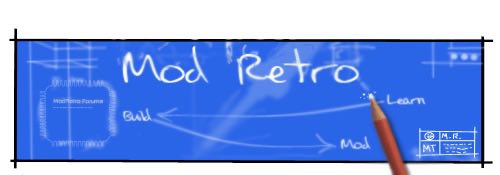Hello all, my name is Mitch, and I have been a long time forum browser, but is a new member. I have been feeling ambitious lately, and I have decided to make my first portable, the Dock64. The name seems dry, so it might get changed later. I want to make my portable different from any other, so I have been thinking of many ideas on how to make mine different. I noticed that people have made adapters for their portables to allow extra controllers and video out.
My adapter or dock will be different from most portables. It will feature (at least for now):
*Ports for all four controllers
*Charging circuit built in
*Built in batteries for extended on the go play
*AV out
*Possible door to store accessories
*No wired connectors (nothing to plug into the portable unit, just set it into the dock and play)
But for now, I am going to focus on building the portable first. The portable itself will feature(at least for now):
*4.3" Screen
*All controller buttons (excluding the memory pack slot)
*Expansion Pack
*3500mAh battery
*Relocated cart slot.
Another thing about my portable in total that I want to try and do is to use as many first party buttons and such as possible.
Basically I thought that I would just post in depth coverage about this unit as possible. (Keep in mind that this is my first portable so things might not be the sleekest one around. Also note that I am not new to hardware modification)
Here is my progress:
First I started off with opening the N64 with a modified screw driver

Once I got the system opened, I tested it to make sure it still worked. (I have fried a N64 before)

Then, while I am waiting on certain parts to ship (copper heat sinks, batteries, and the screen) I thought I would work on getting the controls in the case. (I did measure out how big the screen should be around, and I left room for it)


The image below is after I have gotten the buttons glued in, and sanded down.

I glued the buttons in a way so I could have platformed buttons. In essence there is a lower level which is the portable, then a higher level (about 1 to 2mm above) where certain buttons are, like the D-Pad and the C buttons. Note that buttons A and B are level with the portable.


Now I have filled it in with bondo to get rid of some low spots. I am going to fill and sand it down many times to make sure it is smooth before I start to paint.

I also would like to note that I do not have a certain idea on what I want this to look like as of now. I am just going to "go with the flow" and see how it turns out.
My adapter or dock will be different from most portables. It will feature (at least for now):
*Ports for all four controllers
*Charging circuit built in
*Built in batteries for extended on the go play
*AV out
*Possible door to store accessories
*No wired connectors (nothing to plug into the portable unit, just set it into the dock and play)
But for now, I am going to focus on building the portable first. The portable itself will feature(at least for now):
*4.3" Screen
*All controller buttons (excluding the memory pack slot)
*Expansion Pack
*3500mAh battery
*Relocated cart slot.
Another thing about my portable in total that I want to try and do is to use as many first party buttons and such as possible.
Basically I thought that I would just post in depth coverage about this unit as possible. (Keep in mind that this is my first portable so things might not be the sleekest one around. Also note that I am not new to hardware modification)
Here is my progress:
First I started off with opening the N64 with a modified screw driver

Once I got the system opened, I tested it to make sure it still worked. (I have fried a N64 before)

Then, while I am waiting on certain parts to ship (copper heat sinks, batteries, and the screen) I thought I would work on getting the controls in the case. (I did measure out how big the screen should be around, and I left room for it)


The image below is after I have gotten the buttons glued in, and sanded down.

I glued the buttons in a way so I could have platformed buttons. In essence there is a lower level which is the portable, then a higher level (about 1 to 2mm above) where certain buttons are, like the D-Pad and the C buttons. Note that buttons A and B are level with the portable.


Now I have filled it in with bondo to get rid of some low spots. I am going to fill and sand it down many times to make sure it is smooth before I start to paint.

I also would like to note that I do not have a certain idea on what I want this to look like as of now. I am just going to "go with the flow" and see how it turns out.





















